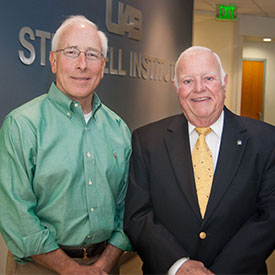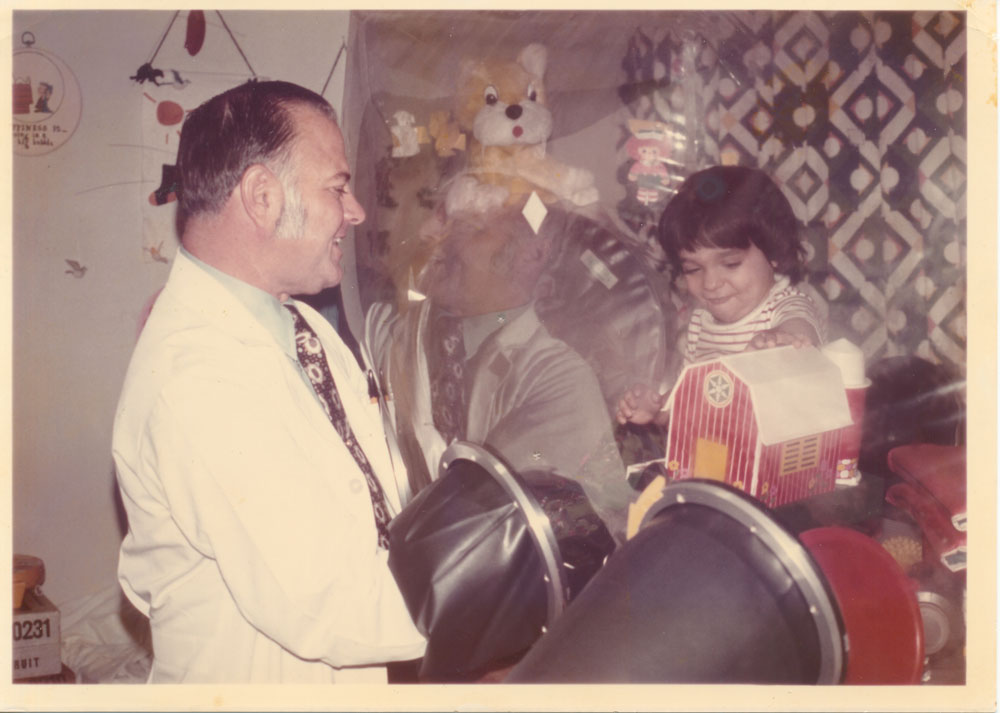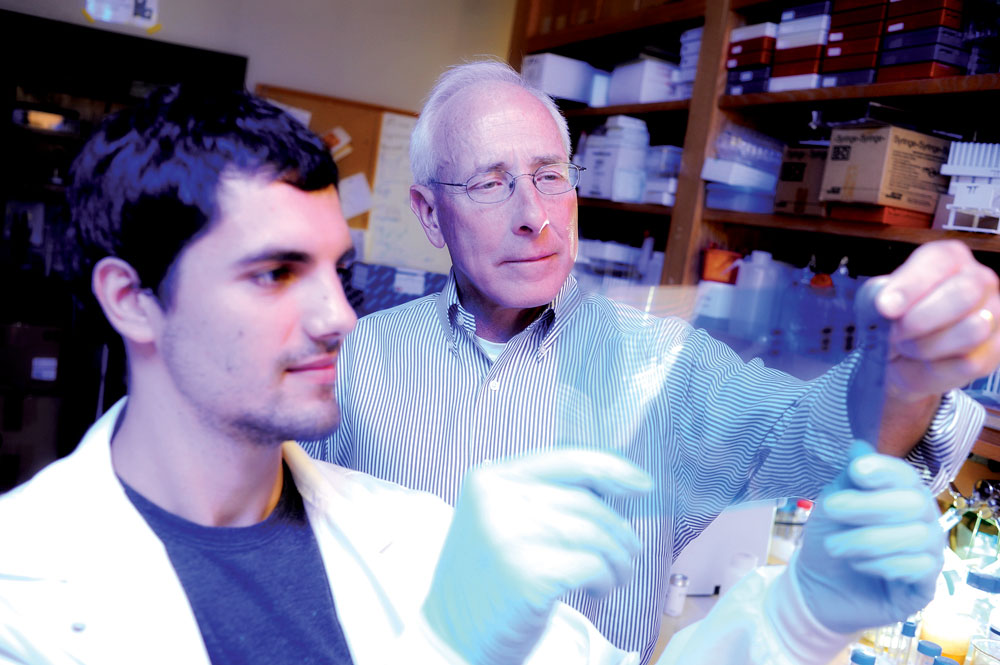 From left: Dr. Tim Townes, director of the UAB Stem Cell Institute, and Dr. Jack Montgomery, of the Huntsville Regional Campus, have both played prominent roles in the search to cure a deadly immune system disease.Although their work is separated by decades, the search to help children with a devastating disease links the careers of two School of Medicine faculty. In summer 2014, two experts in severe combined immunodeficiency (SCID), met for the first time at the UAB Stem Cell Institute. John “Jack” Montgomery, M.D. ’58, now professor emeritus at the School of Medicine Huntsville Regional Campus, became the chief of pediatric programs and professor at the Huntsville campus in 1975.
From left: Dr. Tim Townes, director of the UAB Stem Cell Institute, and Dr. Jack Montgomery, of the Huntsville Regional Campus, have both played prominent roles in the search to cure a deadly immune system disease.Although their work is separated by decades, the search to help children with a devastating disease links the careers of two School of Medicine faculty. In summer 2014, two experts in severe combined immunodeficiency (SCID), met for the first time at the UAB Stem Cell Institute. John “Jack” Montgomery, M.D. ’58, now professor emeritus at the School of Medicine Huntsville Regional Campus, became the chief of pediatric programs and professor at the Huntsville campus in 1975.
He came to UAB from Baylor University, where in 1971 he assisted in the implementation of the first germ-free environmental bubble in the United States for a patient born with severe combined immunodeficiency. That patient was David Vetter, whose life later became the inspiration for the 1976 TV movie “The Boy in the Plastic Bubble,” starring John Travolta. Montgomery was a key member of Vetter’s medical team, and continued to advise the family on David’s treatment after leaving Baylor to join UAB.
“In the past, a child with the disease would not make it through his first year, and definitely not through the second,” says Montgomery. “It was a death sentence for children.”
At the time that Montgomery was working with David Vetter, the only treatment for SCID was a bone marrow transplant. Tim M. Townes, Ph.D., professor in the Department of Biochemistry and Molecular Genetics and director of the UAB Stem Cell Institute, is searching for ways to attack the disease where it originates—in the genes.
 Dr. Jack Montgomery treating David Vetter in his germ-free environmental bubble.The genetic defects that cause SCID affect the function of T and B cells, resulting in a weak immune system that is unable to fight off even mild infections. “There are about 10 genes that are involved in the development of T lymphocytes, which are essential for a functioning immune system,” Townes says. “A mutation in any of those 10 genes could lead to a deficiency of T lymphocytes, and therefore, the disease.”
Dr. Jack Montgomery treating David Vetter in his germ-free environmental bubble.The genetic defects that cause SCID affect the function of T and B cells, resulting in a weak immune system that is unable to fight off even mild infections. “There are about 10 genes that are involved in the development of T lymphocytes, which are essential for a functioning immune system,” Townes says. “A mutation in any of those 10 genes could lead to a deficiency of T lymphocytes, and therefore, the disease.”
Townes’ research utilizes a new a genome editing technology called CRISPR, which is based on a process that occurs naturally in bacteria as a defense mechanism. Scientists have discovered how to use CRISPR to snip out specific genes from DNA and replace them, enabling scientists to edit genomes with unprecedented precision, efficiency, and flexibility.
Townes’ research utilized skin cells from a SCID patient who was successfully cured through a bone marrow transplant. His team then transformed those cells into stem cells and used the CRISPR technique to alter the DNA base pair that causes SCID. In a potential treatment, those cells would be converted to blood stem cells and transplanted back into the patient, curing him or her of the disease. “They would be getting their own cells, but we’ve corrected the mutation in those cells,” says Townes. The research was published in Cell Reports, and Townes expects UAB to launch clinical trials on the SCID therapy within a few years.
 Dr. Tim Townes and a graduate assistant at work in a UAB Stem Cell Institute lab.“At the start of our experience with David and the plastic bubble, I was optimistic that a cure would be found for the disease,” says Montgomery. “But by 12 years into that, I had serious doubts that it would be in my lifetime. The things that Dr. Townes is doing now, it makes some of our efforts look like the Stone Age. He’s getting a specific cell, making it into what he wants it to be, and hopefully, inserting it back into the patient. We had to take a mishmash of cells, some of which were what we were looking for, some of which were absolutely no good at all, and some of which were actually dangerous because we had to transplant cells that had already developed into immune type T cells and B cells. In a body with no defenses, you put those cells in, the same thing happens to the patient that will happen to a graft that doesn’t match—it’ll be rejected, destroyed.”
Dr. Tim Townes and a graduate assistant at work in a UAB Stem Cell Institute lab.“At the start of our experience with David and the plastic bubble, I was optimistic that a cure would be found for the disease,” says Montgomery. “But by 12 years into that, I had serious doubts that it would be in my lifetime. The things that Dr. Townes is doing now, it makes some of our efforts look like the Stone Age. He’s getting a specific cell, making it into what he wants it to be, and hopefully, inserting it back into the patient. We had to take a mishmash of cells, some of which were what we were looking for, some of which were absolutely no good at all, and some of which were actually dangerous because we had to transplant cells that had already developed into immune type T cells and B cells. In a body with no defenses, you put those cells in, the same thing happens to the patient that will happen to a graft that doesn’t match—it’ll be rejected, destroyed.”
According to Townes, while the technology has changed considerably since the 1970s, the fundamentals of scientific discovery remain the same. “The techniques are different, and there’s so much more information now, but the critical part of science remains the interaction of physicians and scientists on an everyday basis. And then we have people like Dr. Montgomery come and share their experiences—it’s important for our students to see that there’s that thread connecting what they do to history. All of science is built on a foundation. That should keep every scientist humble, understanding that it is a team effort over many, many years. And I always tell the people in the lab that it’s like working on a 10,000-piece puzzle. Many people have put pieces in, but we want to put the last piece in.”